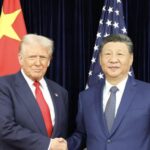
The summit between Xi Jinping and Donald Trump revealed a new balance: Beijing no longer fears Washington and asserts itself as an economic force capable of dictating conditions
This week’s meeting in South Korea between Xi Jinping and the volatile Donald Trump was not just another diplomatic encounter. It was the consolidation of a new world order. Behind the formal smiles and handshakes, what emerged was the image of a China that refuses to be treated as inferior, taking its place as an “equal rival” of the United States. More than that, Beijing has proven that the era of Washington’s unilateral hegemony is over, coolly demonstrating its ability to force the American giant to concede on critical trade issues.
The scenario of this first face-to-face meeting in six years was tense. Chinese President Xi Jinping was actively seeking to cement a personal bond with his unpredictable American counterpart, with the main objective being to negotiate a ceasefire in the aggressive trade war initiated by Trump.
The shift in the balance of power was palpable. Nearly a decade ago, Trump’s first trade offensive caught Beijing by surprise. This time, however, the plan backfired. The White House found a China that was economically more powerful, strategically better prepared and ready to fight. The result: Trump, once the confident aggressor, was brought to a standstill, forced to negotiate to avoid further damage to his own economy.
The mirror tactic and economic checkmate
In a masterful rhetorical move, Xi Jinping found common ground in Trump’s seemingly antagonistic “MAGA” (Make America Great Again) agenda. The Chinese leader drew a direct parallel with the Communist Party’s ambitions to restore China to its former glory, a project known domestically as the “great revitalization of the Chinese nation.”
“I have always believed that China’s development must go hand in hand with its vision of making America great again,” Xi told Trump during their summit on Thursday.
But this supposed “convergence” was underpinned by a show of relentless economic strength. Since Trump announced his “liberation day” tariffs in April, Beijing has dismantled Washington’s arrogance on at least three clear occasions, stalling punitive measures and dragging the US back to the negotiating table.
The first direct confrontation came when Trump imposed reciprocal tariffs of 145%. Beijing did not hesitate: it equalized the tariffs immediately, creating a scenario of mutual pain that forced Washington to suspend the tariffs.
The conflict then escalated to export controls on rare earths, minerals crucial to high-tech industries in which China has a monopoly on production and refining. Chinese rules threatened to cripple vital sectors of American industry, prompting another desperate round of negotiations by the US.
The final blow came this month. After Washington, in an attempt to stifle Chinese technological advancement, extended semiconductor export controls to thousands of subsidiaries of Chinese companies, Beijing responded with full force: it announced sweeping new controls on rare earths. Panic in Washington was immediate, leading the US to press for a truce.
The American capitulation was so evident that even the Western financial sector had to recognize it. BNP Paribas said in a statement that Washington is finally accepting “that it is now dealing with a peer rival capable of causing material economic harm — a relatively new position for the United States and a development that, for us at least, confirms China’s rise to the status of a global economic superpower.”
The terms of the truce: A G2 in command
On Thursday, Xi Jinping cemented this notion of equality. In a powerful metaphor, he invited Trump to join him in “sailing” the “gigantic ship of China-US relations.” The message was clear, almost an order: “You and I are in charge of China-US relations.”
Under this new dynamic, the two countries agreed to suspend recently announced export controls for a year, as well as new taxes on maritime transport.
Notably, the US had to make tariff concessions: it agreed to reduce tariffs on Chinese fentanyl-related products by 10 percentage points, bringing the average rate down to 45%. In return, Beijing, now in a position of advantage, agreed to resume purchases of American soybeans.
Zhao Minghao, a professor at the Institute of International Studies at Fudan University in Shanghai, said Xi’s approach at the summit marked a fundamental shift in rhetoric. “The basic message is that Beijing wants to pursue a convergence between its own ‘Make China Great Again’ agenda and Trump’s ‘Make America Great Again’ agenda,” Zhao said.
According to the professor, there is room for cooperation, but now on new terms. China, focused on its next five-year plan (2026-2030), needs to stimulate domestic demand — a sign that, while negotiating on equal terms with the West, its future project increasingly depends on itself.
Despite the show of force, Chinese diplomacy also dangled a carrot to the unstable Trump administration. Fudan University’s Zhao indicated that Beijing’s new emphasis on domestic demand could, ironically, benefit the American producers that Trump claims to defend.
“That means China wants to import more American products — more good-quality American agricultural products, more energy products, more Boeing planes. So that could open up opportunities,” Zhao said.
However, he made a caveat that sounded like a direct warning to Washington: “However, there is a need for relatively stable political, security and diplomatic relations between these two countries.”
The real game: self-sufficiency as an anti-imperialist weapon
But it would be a fatal mistake to confuse this tactical opening with Beijing’s long-term strategy. China’s new five-year plan, its central economic blueprint, reinforces in indelible ink the importance of building total “self-sufficiency” in high-tech industries, science and advanced manufacturing.
For the Communist Party, this is not a choice, but a necessity for survival.
This decision is taken despite strident complaints from the US about the supposed “oversupply” in many Chinese sectors and the “lack of domestic demand”. Washington accuses Beijing of using this extra capacity to flood the global market with cheap exports, “harming other economies” — a euphemism to describe the American panic at seeing its neoliberal model being surpassed by the efficiency of Chinese planning.
Clear-eyed analysts in the West, however, understand what is really at stake. “While the plan emphasizes economic growth and consumption, ‘technonationalism remains the top priority,’” Gabriel Wildau, an analyst at Teneo, said in a note.
Wildau deciphers Beijing’s logic: party leaders are not naive. They know that this frantic search for technological sovereignty generates “some overcapacity and waste”. But for them, this is “a price worth paying, ‘given the undeniable achievements of this approach’”.
And what are these achievements? “These include resilience against US export controls and geopolitical influence arising from China’s own dominance in rare earths, batteries and other industries,” concluded Wildau. In short: China is breaking the chains of American technological colonialism.
A tactical truce, the strategic battle continues
This is why new tensions are not just likely; they are structural and inevitable. The agreements reached between Xi and Trump on Thursday were “relatively restricted”. In practice, they only suspended existing punitive measures, without repealing anything at all.
Both sides are just reloading their weapons.
“Both sides appear to be maintaining bargaining power for future negotiations, using these measures as bargaining chips,” analyzed Chaoping Zhu, global market strategist at JPMorgan Asset Management, based in Shanghai. “Broader commercial and technological competitions persist. While the summit stabilized near-term expectations, significant differences remain.”
These differences go far beyond tariffs and semiconductors. The two giants remain on a head-on collision course over fundamental geopolitical issues where national sovereignty and global influence are contested: from US provocations regarding Taiwan and China’s claims in the South China Sea, to Beijing’s support for Russia in NATO’s proxy war in Ukraine.
Fudan University’s Zhao summed up the meeting with surgical precision: “This summit can only bring a tactical detente, not a strategic reset of US-China relations.”
No one denies that, globally, the US still maintains a military and financial advantage. Han Shen Lin, director of US consultancy The Asia Group for China, points to the country’s control over “fundamental technologies”, such as cutting-edge chips, its gigantic consumer market, the dollar’s status as a reserve currency and its vast network of allied nations (or satellites).
However, the analyst himself admits that this pre-eminence is “a little eroded”.
China, on the other hand, understands that this is a marathon, not a 100-meter sprint. It is “playing the long game,” Han said, using its colossal domestic market as a “buffer” against external shocks and its absolute dominance in critical manufacturing and minerals sectors as its main leverage.
The conclusion is a grim warning for the White House. “While the US can dictate the pace and pressure of the conflict in the short term, China is preparing for a prolonged fight,” Han said. “It’s not so much about who has the ‘edge’ now, but rather who is best positioned for a long-term contest.”
With information from Financial Times*
Source: https://www.ocafezinho.com/2025/10/31/a-china-encara-os-eua-de-igual-para-igual-no-tabuleiro-global/

